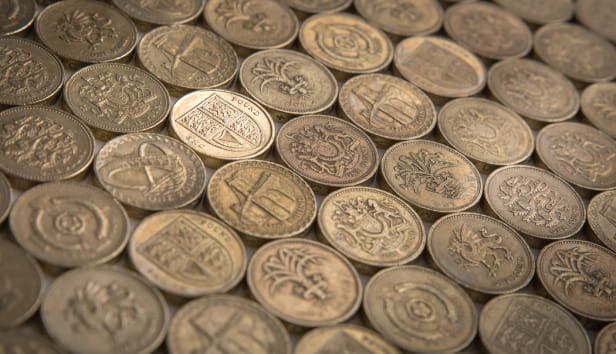
This article is for general guidance only and is not financial or professional advice. Any links are for your own information, and do not constitute any form of recommendation by Saga. You should not solely rely on this information to make any decisions, and consider seeking independent professional advice. All figures and information in this article are correct at the time of publishing, but laws, entitlements, tax treatments and allowances may change in the future.
You’ve spent years saving into a pension – now you get to spend it. But it’s not completely straightforward when it comes to taking your money out to pay for your lifestyle in retirement, since there are a number of options. What works best for you will largely depend on how much flexibility you want or need, and your attitude to risk.
Here we explain the four main routes you can choose from if you have a defined contribution pension, with the pros and cons of each.
On this page:
.jpg?sc=max&mw=800&h=450&la=en&h=731&w=1300&hash=AA2577C39B4AE89DFE8853AC853A5B63)
You can take all of your total pension – however much it is – as a cash lump sum. This is known as Full Pension Encashment (FPE). The advantage is you get full access to all your retirement money in one go, to do with as you wish.
The downside – and it’s a big one – is that you can end up paying far more tax on your pension than you might otherwise. While up to 25% of the value of your pension can be taken tax-free, the rest will be added to your income for the year and taxed at your marginal rate.
So, if the remaining pension you cash in pushes your income over £50,270 for the year, you will have to pay tax at the higher rate of 40% on your withdrawal. On any cash that takes your income over £125,140, you’ll have to pay tax at the additional rate of 45%.
Complicating matters even further, it’s likely that you will pay emergency tax on your withdrawal, which is likely to be at a higher rate. However, you can reclaim any refund you are owed by contacting HM Revenue & Customs (HMRC).
You can use this Which? tax calculator to see how much tax might be taken before you receive your cash. If you cash out all of your pension, the money that you haven’t spent usually becomes part of your estate when you die and so is subject to inheritance tax.
Another option is to take one or a series of lump sum payments from your pension, known as uncrystallised funds pension lump sums (UFPLS). To account for your tax-free cash, 25% of each lump sum is paid tax-free, with the remaining 75% subject to income tax.
However, as with option 1, you could end up with a hefty tax bill because the taxable part of your withdrawal will be added to your income for the year and taxed at your highest rate – potentially bumping you into a higher-rate tax bracket. You could also be stung with emergency tax and will need to claim a refund from HMRC to get your overpayment back promptly.
What’s left in your pension pot remains invested. Emma Watkins, managing director at Scottish Widows, says: “The benefit of UFPLS is that you save the administration otherwise needed to convert your lump sum into an income via drawdown or taking out an annuity.”
But she warns: “On the flip side, people need to bear in mind the tax implications which can eat into their income, as well as the danger of taking too much too early and running down their pot too soon.”
Currently, if you die before age 75, anything left in your pension can be paid to your beneficiaries tax-free. After age 75, anything paid out will be taxed at your beneficiary's marginal rate of income tax. At the moment pensions do not form part of your estate when you die, which means they are not subject to inheritance tax. However, this is set to change from April 2027.
/health-compare-page-1440x640-(1).jpg?sc=max&mw=800&h=450&la=en&h=572&w=1300&hash=0FDC30E8C5A9695120C10D984331273F)
Drawdown – also known as flexi-access drawdown (FAD) – is a way of taking income from your pension, where your pot remains invested. What usually happens is you first take your 25% tax-free cash as a lump sum.
You can then decide how much to take out of your pension and when. You might decide to take a regular monthly income or make less frequent withdrawals. You can even leave your money untouched if you want your tax-free lump sum but aren’t ready to take an income yet.
Beyond your 25% tax free cash, withdrawals will be taxed at whatever tax band you fall into, depending on your level of total income. However, to help you manage your income more tax-effectively, some pension providers will let you take this in portions.
Ian Cook, financial planner at Quilter Cheviot Financial Planning, says: “Check the small print on your paperwork before drawing down. Does your provider offer the ability to draw a nominal income and a higher amount of tax-free cash each month, to reduce your income tax liability in those early years [when you are more likely to be active and spending more]?”
The appeal of drawdown is that it does give you total flexibility and control over your income – which is great if your requirements aren’t set in stone, or are likely to change over the course of your retirement.
As your money remains invested, there is also the potential for your pot to carry on growing, which can help you deal with rising costs over time. However, it’s important to understand the risks.
Your pension will remain invested and you will need to manage withdrawals carefully to ensure you don’t run out of money: your income is not guaranteed. “People often underestimate how long they will be retired,” says Cook.
“If you are retiring from work at age 60, it is very conceivable that the pot needs to last for 25 years or longer,” he says.
If the stock markets falter and your investments aren’t performing well, you may need to reduce your income for a period, or take money from other sources like savings accounts, to ease the pressure on your pension and preserve its lifespan.
This drawdown calculator from Which? can give you an indication of how long your pot is likely to last. To reduce the risks of running out of money, wealth planners often advise people not to draw down more than 4% a year. The actual withdrawal amount can be adjusted each year in line with inflation.
Even if you follow this rule, it isn’t guaranteed that your pension pot will last as long as you need it to. It’s also worth thinking about what standard of living you want for your retirement.
The inheritance rules for drawdown pensions are the same as for UFPLS. Currently, if you die before 75, any money not cashed out of your pension pot can be paid to your beneficiaries, tax-free. After age 75 it will be taxed as your beneficiary's income.
But as we’ve mentioned, from April 2027, unspent funds in pensions will become subject to inheritance tax, and will be taxed again as the beneficiary’s income if you’ve died after the age of 75.
.jpg?sc=max&mw=800&h=450&la=en&h=731&w=1300&hash=A17F361A6D51309C41BBCFDDF2BE0600)
The final option is to buy an annuity. This means you hand over all or part of your pension pot to an annuity provider and they give you a guaranteed fixed monthly income. Make sure you shop around for the best annuity rates – you don’t have to buy an annuity from your pension provider.
Some people choose to take their tax-free cash lump sum (up to 25%) first, and then use the remainder to buy an annuity. The income payments from an annuity are taxable.
You can also buy what’s known as a purchased life annuity with money that’s not in your pension pot, or with your tax-free lump sum. You can then choose from the same types of annuities as if you were buying from your pension pot, but the tax you pay on the income is calculated differently (in general, you pay tax on the income you earn from the growth in your investment, but not on the portion of the payments that comes from your original investment).
Watkins says: “Annuities’ main advantage is they offer simplicity and security to people who are not comfortable with investment risk, don’t want the worry of managing their drawdown funds or face the possibility of running out of money.
“However, security does come at the cost of flexibility. Once you have purchased an annuity, it is very difficult to change the terms of your agreement if your circumstances change unexpectedly.”
That said, Mike Ambery, retirement savings director at Standard Life, points out that there are different ways to use annuities.
“This might include annuitising a portion of your savings, or in stages through retirement, which can help protect your income from the impact of inflation, allowing you to leave a portion in drawdown to benefit from potential investment growth,” he says.
An annuity can’t be passed on as an inheritance. If it’s a lifetime annuity, payments will stop when you die. However, you can arrange for your partner to continue receiving an income from your annuity after your death. To do this, you’ll need to choose a joint life annuity in the first place.
.jpg?sc=max&mw=800&h=450&la=en&h=731&w=1300&hash=4DBF4AA26CB11B0E5C4F38C8AE806728)
Working out which of these four options – or a mix of them – is right for you can be tricky. We’ve got more information in our piece on when and how to take your pension. Pension Wise is a service from MoneyHelper, backed by the government, that offers free, impartial guidance to over-50s.
It can’t provide personalised advice, but can explain the options to take money from your defined contribution pension pots. Online appointments with Pension Wise are self-guided and can be done at your own pace.
Appointments on the phone last around 60 minutes. You can book an appointment online or by calling free on 0800 138 3944.
If you’re still paying into your pension when you start to take your pension, bear in mind that the way you take your pension could potentially affect the amount of tax relief you get on your contributions.
The Money Helper website has more about this. If you want bespoke advice (rather than guidance), speaking to a regulated financial planner can help.




What you need to know from the latest update

Discover our easy ways to take control of your finances, from doing your tax return to assessing your savings.
/mature-couple-looking-at-taxes.jpg?la=en&h=650&w=1400&hash=5CFABEEDC751F26D56DD3E85749E3C36)

Hunt out those old pound coins and banknotes to see how much they could be worth.
.jpg?la=en&h=354&w=616&hash=458B0288E9852F4B63A433E2FDD375E7)


